
Deb Mell’s uncanny artwork often leaves one wondering. Her paintings are populated with recurring characters — half animal, half human — rendered in meticulous black-and-white marks. They float through spaces in uneasy relation to each other. Their serpentine arms hug and pinch. Are they enemies or lovers? What world is this? The pictures nod to prehistoric art with their dome shapes, passages of paint that look like raw pigment, and animal silhouettes that resemble cave drawings. The pictures suggest a fully formed reality, perhaps an unearthed primitive society or an alien world existing parallel to our own.
Greeting a visitor to her Truro home, Mell is not the shaman one might expect from her artwork. Originally from southern Illinois, she is wearing red, chunky glasses and her short blond hair is slightly disheveled. It’s 10:30 in the morning, and she just woke up.
“I work at night until I can’t see,” she says. She got used to working late in Maplewood, N.J. where she raised three children and worked full-time. “I never slept,” she says. Now, late nights are part of her natural rhythm. “Everything is so quiet. There are no interruptions.”
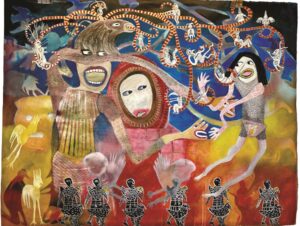
She often winds down before sleep by working on drawings arranged in grids, which appear like the spread-out pages of a sketchbook. There are a few of them in her current show at the Wellfleet Adult Community Center. Each grid contains a different character. These humorous beings often break out of their tiles, interrupting the grid with an action that stretches across the composition, as in one piece where fishlike droplets come from a character’s mouth, spreading like germs across the picture.
Mell creates both paintings and sculptures, and many of the latter have taken up residence in her home. “I’ve been making art my whole life,” says Mell. “It’s in every crevice of my house.” In a corner of the dining room stands one of her totems — an all-white humanlike figure. She likes to embellish her art with beads and other small objects, including matches and doll parts. The bust of a deer over her fireplace and a dining room chair both sport shiny beads in an over-the-top arrangement of colors and textures. “I try to see how much I can fit in something and still make it work,” says Mell. “I want people to revisit the work and be surprised and see new things.”
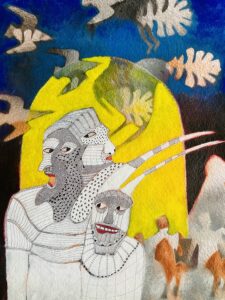
Mell’s approach to artmaking is holistic. Just about everything in her orbit spills into her art. “I’m taking the things I know and spitting them out,” she says. “I borrow a lot from art history.” She notes affinities for Mexican, Egyptian, and African art. “Where I grew up, folk art was art,” she says.
At one point she worked at a museum repairing African masks — an influence evident in her shamanistic sculptures, which look like they could be artifacts of religious rituals. She also pulls freely from the materials around her. In one totem, she used the jaw of a fish for a mouth, and she’s currently reworking failed prints with beads and paint. The frames are from discarded mirrors that she painstakingly decorates with roses and baby’s heads, cast in clay from butter molds. Her paintings in the Wellfleet show were created on homemade paper her daughter gave her, but since that ran out she has moved on to other surfaces. She’s creating a pair of large-scale paintings on linen shower curtains in her basement studio.
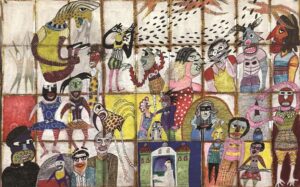
The landscape has also seeped into Mell’s art. When she moved to Truro 12 years ago, she told herself she would never paint landscapes, water, or boats. “I was a little nervous because the art here wasn’t like the art I lived with in New York and New Jersey,” says Mell. Yet one of her most recent large paintings is dominated by wavelike lines and a landscape reminiscent of the dunes.
“Now I’m doing landscapes,” says Mell. “I didn’t mean to do them. It just happens like that.”
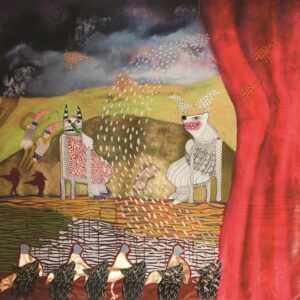
Animals have long played a dominant role in her work. “We had a whole menagerie of animals growing up,” says Mell. Her father, who worked as a meat inspector, would often bring home calves or lambs, which they would raise. She had a pet snake that she wore around her neck to school one day, and her childhood bike was decorated with tails of squirrels, which her family hunted and ate. “I think of people and animals and nature as all part of one thing,” says Mell.
Mell’s great-grandmother is the inspiration behind a figure in a red and white dress sitting on a chair in one large landscape painting. “She had these patterned dresses and was sort of heavy and scary,” says Mell. The figure has a cucumber for a nose.
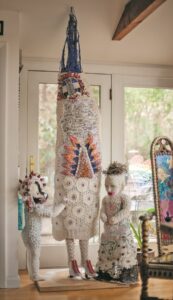
For all their eccentricity, Mell’s paintings relate closely to her life. “A lot of these works are my family stories,” says Mell, who grew up as the “disappointing oldest” in a poor rural family that didn’t seem to understand her. Instead of taking dance classes or joining the Girl Scouts as her parents hoped, Mell started painting with a group of adults when she was in sixth grade. It was around this time that she also wrote to her state representative inquiring about college scholarships. “I was a weird kid,” says Mell, and she knew she wanted out of small-town Illinois. Although her parents had no interest in her going to college or pursuing art, she found an ally in her grandfather.
“My grandfather made stuff,” says Mell. “He let me make things in his basement and always encouraged me to do what I wanted. Without him I probably wouldn’t have survived, and I definitely wouldn’t have gone to college.” Her grandfather, who had only a fifth-grade education, worked as a janitor and a miner. In his free time, he made carvings from roots and “very decorative” birdhouses. “He was a thinker and a naturalist,” says Mell. “We fished almost every day, and he taught me how to see.” He also taught her how to carve and build miniature boats, including one that Mell decorated with a whole box of nails. It promptly sank. “He just let me figure it out,” says Mell.

After finishing art school on a scholarship at Illinois State University, Mell moved to New York in 1977 for a one-year studio program at the Brooklyn Museum. “I was doing minimal work like everyone else — until I wasn’t,” she says. “My work always had double meanings and was very narrative in my own head, but when I explained it, it was all about process, because that was the time period.” Soon she began meeting feminist artists breaking that mold and, after exhibiting a piece in a show where artists unveiled their closeted work, found the courage to forge her own path.
A consistent image in the background of her paintings is a domelike shape inspired by the Cahokia Mounds near her hometown of Collinsville, Ill. She remembers them as hills she would sled down; they have since become a UNESCO World Heritage Site and celebrated landmarks of a pre-Columbian culture. The presence of these forms in her paintings invites an archeological reading of the pictures. She’s unearthing her past and looking under the overlooked landmarks of her life.
“I start thinking about my past and about stories that weren’t told,” says Mell. “Your past and who you are is always with you.”
Deb’s World
The event: Paintings, drawings, and collages by Deb Mell
The time: Through April 30
The place: Duck Pond Gallery at Wellfleet Adult Community Center, 715 Old Kings Hwy.
The cost: Free
